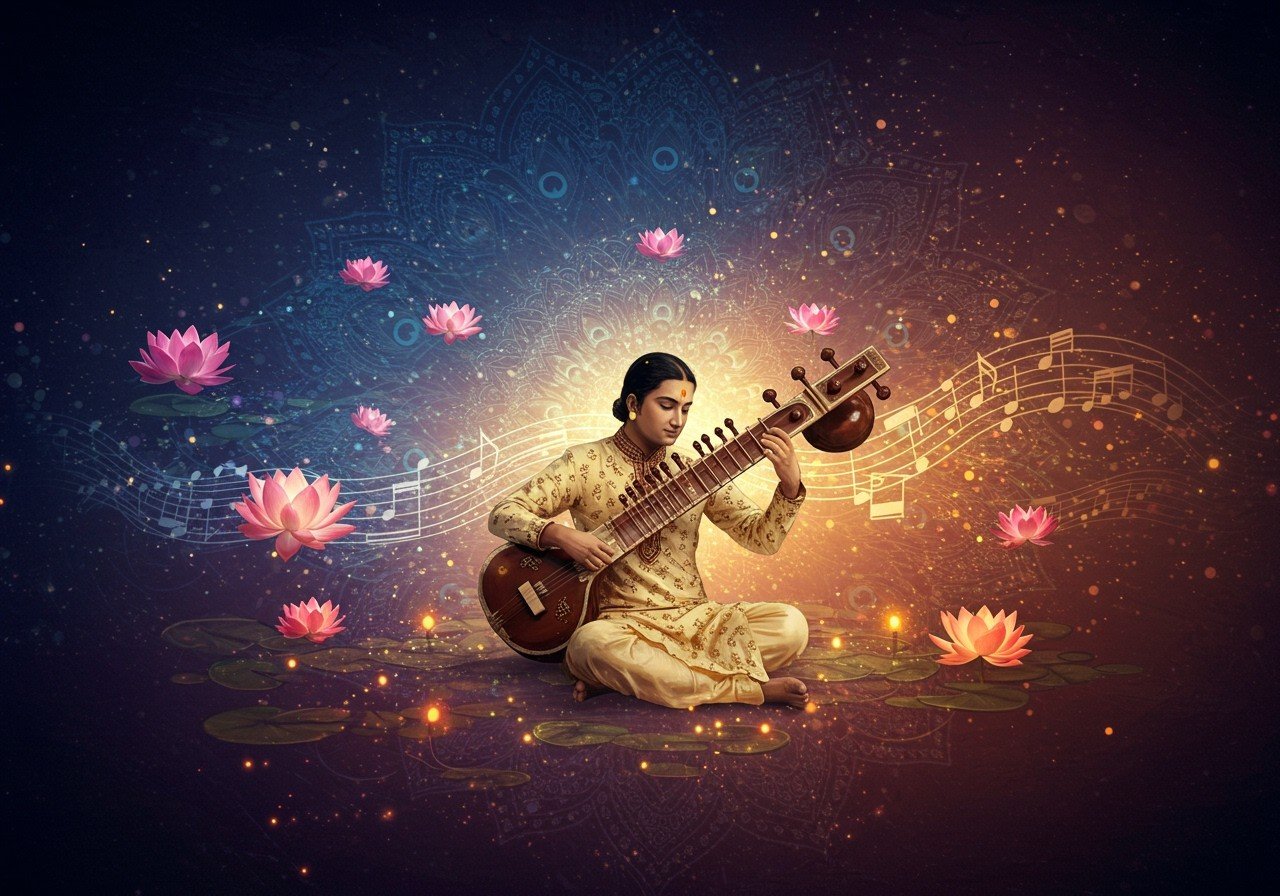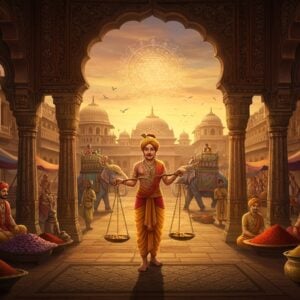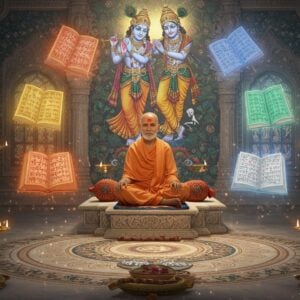
Indian classical music, a tradition steeped in history and brimming with emotion, finds its core in the enchanting world of ragas. These melodic frameworks, with roots in ancient Vedic texts like the Samaveda, serve as the building blocks of musical expression, evoking a spectrum of moods and weaving tales of devotion and cultural heritage. Ragas play a crucial role in both spiritual and cultural practices across India, influencing various musical genres even today.
Understanding the Essence of Ragas
Ragas are more than just melodic patterns; they are structured frameworks that breathe life into Indian classical music. Each raga is a unique combination of notes (swaras) and specific rules that govern their progression, creating a distinct emotional landscape.
The term “raga” itself originates from the Sanskrit word “rang,” meaning color or mood, highlighting its power to paint vivid emotional pictures in the listener’s mind. Each raga unfolds through a defined ascending scale (aarohana) and a descending scale (avarohana), providing a canvas for musical creation.
Time and Season Play a Role: The magic of ragas extends beyond their melodic structure; it’s deeply intertwined with the rhythm of nature. Traditionally, each raga is associated with a specific time of day or season, amplifying its emotional resonance. Imagine the serenity of a morning raga like Jaunpuri or Bhankar, greeting the dawn with its gentle melodies. Or perhaps the evocative strains of Gaud Malhar and Miyan Malhar, perfectly complementing the dramatic monsoon season.
Explore the rich tradition of bhajans and kirtans in our related blog post.
Unraveling the Melodic Tapestry
Seven Primary Notes (Swaras): A raga is built upon a foundation of seven primary notes, known as swaras, mirroring the notes in Western music. At least five of these swaras, arranged in a specific sequence, must be present to qualify as a traditional raga. The notes Sa (Shadja) and either Ma (Madhyama) or Pa (Panchama) typically anchor the raga, providing its distinctive melodic character.
Emotional Resonance (Rasa): At the heart of every raga lies its emotional character, or “rasa.” This unique essence evokes a range of feelings, from the depths of love and humor to the tranquility of peace. The rasa connects the listener to the music’s very soul, creating a deeply personal and immersive experience.
Evolution and Interpretation: Ragas are not static entities frozen in time. They have evolved over centuries, with interpretations varying across different musical traditions. This dynamic evolution is particularly evident between the Hindustani (North Indian) and Carnatic (South Indian) schools of classical music, adding layers of richness to this ancient art form.
Key Ragas of Hindustani Music
Within the vast expanse of Hindustani classical music, certain ragas stand as pillars of the tradition. Ragas like Bhairav, Yaman, and Bhimpalasi are celebrated for their distinctive characteristics and the profound emotions they evoke. These ragas are frequently featured in performances by renowned musicians, highlighting their enduring significance in the cultural landscape.
Celebrate the bond of brotherhood with our exquisite rakhis.
A Symphony of Classifications
In Hindustani classical music, ragas are systematically classified into groups known as thaats. The renowned music scholar Pandit Vishnu Narayan Bhatkhande identified ten fundamental thaats: Asavari, Bhairav, Bhairavi, Bilawal, Kafi, Kalyan, Khamaj, Marwa, Poorvi, and Todi. While the total number of Hindustani classical ragas is estimated to be around 300, only about a third of them are actively performed today.
The Art of Performance
Improvisation: Ragas are not merely rigid structures; they offer a vast playground for improvisation. Musicians weave their creativity within the framework of the raga, exploring its nuances and expressing their individual interpretations.
- Alap: The performance typically begins with the alap, a slow, unmetered exploration of the raga’s notes, setting the stage for the emotional journey ahead. This introductory section is crucial in establishing the mood of the raga.
- Jod and Jhala: As the performance progresses, the jod and jhala sections introduce rhythm and tempo, adding a dynamic element to the melodic exploration. Here, the musician’s virtuosity shines, as complex rhythmic patterns are interwoven with the raga’s melodic framework.
Tala – The Rhythmic Counterpart: Tala, the rhythmic cycle, complements the melodic structure of the raga, providing a rhythmic canvas for the musical expression. The interplay of melody and rhythm creates a captivating and dynamic performance.
Traditional instruments like the sitar, tabla, and harmonium are often employed in Hindustani classical music, each contributing its unique sonic texture to the rich tapestry of the raga.
Enhance your puja experience with our beautiful Baran Dala sets.
Cultural and Spiritual Significance
Ragas hold deep cultural and spiritual significance in Indian society. They are often incorporated into religious ceremonies and rituals, enriching the spiritual atmosphere. In contemporary times, the potential benefits of ragas for mental health and emotional well-being are being explored, suggesting a deeper connection between music and inner peace.
Frequently Asked Questions
What defines a raga in Hindustani music? Ragas are melodic frameworks with specific rules governing note usage and mood. They are like musical blueprints, guiding the musician’s expression. They are much more than simple scales, embodying emotional depth and spiritual significance.
How many ragas exist in Hindustani classical music? Hindustani classical music boasts hundreds of ragas, each possessing a unique sonic identity and emotional character. This vast repertoire ensures a rich and diverse musical landscape.
Are ragas exclusive to Hindustani music? While fundamental to Hindustani music, ragas also play a vital role in Carnatic music, the other major stream of Indian classical music. Both traditions utilize ragas, though their approaches and classifications differ.
Why are ragas considered so important? Ragas form the very foundation of Hindustani music, dictating the mood, structure, and emotional expression of a musical piece. They serve as a guide for the musician, helping them create specific atmospheres and evoke desired feelings.
How do musicians select a raga for a performance? The choice of raga depends on several factors, including the time of day, the season, and the specific emotions the musician wishes to convey. Each raga has its own unique association with a particular time or mood, creating a nuanced and context-sensitive performance.
Is improvisation a part of raga performance? Yes, improvisation is an integral part of Hindustani music. Musicians often improvise within the structure of a chosen raga, demonstrating their skill and creativity while respecting the raga’s essence.
How do ragas differ from Western scales? Ragas are distinguished by their use of microtones and specific patterns of ascending and descending notes, which differ from the fixed patterns found in Western scales. This nuanced approach to melody gives ragas their unique character.
Are certain instruments particularly associated with ragas? While ragas can be performed on any instrument, some instruments, such as the sitar, tabla, and harmonium, have become closely associated with Hindustani classical music, enriching its sonic palette.
Poojn.in: Your Gateway to Sacred Sounds
At poojn.in, we understand the profound role of music in spiritual practices. We offer a curated selection of items to enhance your puja rituals with sacred sounds.
Explore our range of:
- Kalash, Kumkum, and Roli: Essential for auspicious beginnings and traditional ceremonies.
- Hawan Samagri: Create a sacred atmosphere with fragrant offerings for your havan.
- Traditional Bells, Shankhs (conch shells), and Manjiras (cymbals): Infuse your puja with sacred sounds and vibrations.
Experience the convenience of shopping with us:
- Browse our extensive collection at poojn.in
- Personalized product guidance at 03369029784
- Quick assistance via WhatsApp at 9476142738
- Free shipping on orders above ₹500
- Secure packaging for all items
All our products are carefully sourced and quality-assured. Visit poojn.in today to discover a world of puja essentials.
Embracing the Timeless Legacy of Ragas
Hindustani classical music, through its captivating ragas, offers a profound journey into the heart of human emotion and cultural heritage. Ragas are more than just melodic structures; they are expressions of our deepest feelings, connecting us to a rich tapestry of traditions and spiritual experiences. Each performance, whether traditional or contemporary, brings a unique perspective, ensuring that the legacy of ragas continues to flourish.
We invite you to immerse yourself in the enchanting world of ragas and experience the transformative power of Hindustani classical music. Explore its depths, connect with its emotions, and embrace the timeless beauty it offers.


